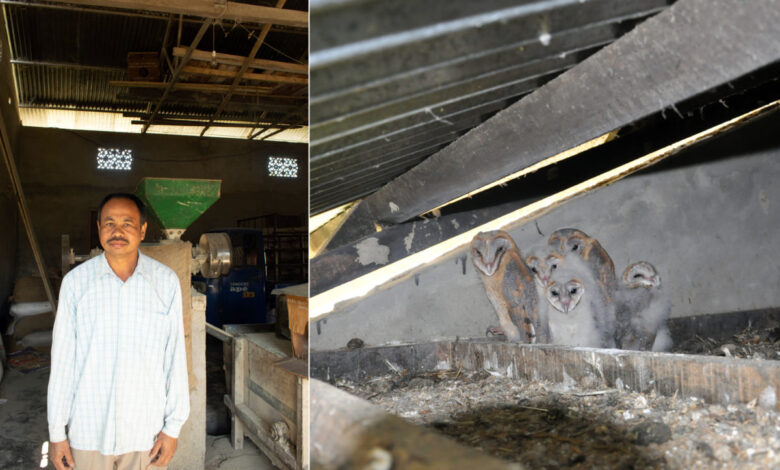Artificial nests for barn owls help Assam farmers befriend natural rodent killers

Kasturi Das
On a cold winter morning in late 2009, Dilip Konwar, a sprightly man in his late forties, scrambled up a bamboo ladder and peeked into the dark insides under the roof of his shop, to investigate the mysterious sounds coming from there. As his eyes adjusted to the darkness, Konwar saw a group of barn owl chicks, huddled together. Scattered around were severed heads of rats, snakes, and garden lizards.
Konwar lives in Gohaingaon, a village in Kadam tehsil of Assam’s Lakhimpur district. In this part of India, barn owls (Tyto alba), locally known as lokkhi phesa, are considered auspicious. The lokkhi phesa, named after Lakshmi, the Hindu goddess of wealth and good fortune, represents the vehicle of the goddess and is considered to be a bird of wisdom.
Attached to the back of Konwar’s grocery shop is his rice mill, which stands next to a paddy field and a small bamboo grove. During this time, there was a heavy infestation of rats in the area, an occurrence that Konwar attributed to his mill. But as time passed, Konwar noticed a significant decrease in the rat population. “It seemed to me that the owls were preying on rats from all over this area to feed their young. It saved my grains,” said Konwar.
Barn owls are prolific hunters. They are known as “farmers’ friends” as they feed on over 20 small mammal species worldwide including rodents, acting as natural pest control. Konwar saw it as an advantage and decided to move the family of owls from under the roof to inside the mill. Eventually, the owls became accustomed to having humans around and became friendly with Konwar’s family and neighbours.
Soon, the news of Konwar’s owls reached the Regional Agricultural Research Station (RARS), of the Assam Agricultural University, in North Lakhimpur.
The rice mill experiment
When Prabal Saikia, an ornithologist and chief scientist of RARS, learned about Konwar’s owls, he began to design nest boxes, to conduct an experiment. Saikia designed a prototype with soft plywood. It had a removable lid and holes on two sides for ventilation; an entrance hole measuring six inches in diameter, and a platform in front for young owls to exercise their wings before their first flight.
In September of 2012, two artificial nest boxes were placed at a height of 10 feet from the ground inside the mill; one of the boxes got its occupants by October: a pair of barn owls.
“In Assam, we advise farmers to install these nest boxes in October, before the Durga Puja festival, because the breeding season starts from November. The breeding cycle is completed within four months: October to January,” said Saikia.
When Saikia studied the regurgitated pellets of the owls, collected from Konwar’s mill and nearby areas, he found that more than 90% of their diet comprised rodent species – bandicoot rats, house rats, field rats, and grey musk shrews. Barn owls throw up undigested parts of their food after their digestive system has finished extracting the required nutrition. These lumps of vomit, known as pellets, which often contain bones, feathers, tails, fur, teeth, and indigestible parts of their prey, are studied by researchers to determine the birds’ diet. The nest boxes in Konwar’s mill saw 100% success in egg hatching, breeding, and fledging.
Since then, the owls have been coming back every year around October.
In 2012, the year this experiment began, 36 roosting sites were recorded in Lakhimpur district. Common roosting sites were found to be in buildings, namghars (Assamese prayer houses), trees, and artificial wooden nest boxes.
As part of the experiment, in 2014, Lakhi Prasad Hazarika, currently the principal of a college in Darrang district, set up a nest box in the Bowalguri area of North Lakhimpur town, behind North Lakhimpur College where he was previously working as an associate professor of Zoology.
“There was a pair of barn owls and their five owlets. I had counted over 1,270-odd skulls of rats in that area. Rats cause substantial losses to farmers during harvest season. So, if one pair of owls kills over 1,200 rats in one area over a short period, it is an indication that the rat population is in control,” Hazarika said.
After the success of the first experiment, RARS created more nest boxes and distributed them amongst farmers across Lakhimpur, Dhemaji, and Jorhat districts between 2013 and 2015.
Of the 15 nest boxes installed in various sites, seven were used by barn owls for roosting and nesting. This occupancy rate proved that there were not only insufficient natural nesting sites available but also that nest boxes could be used to increase the barn owl population in agricultural areas.
Need for data on owls
However, there is a lack of official data on barn owl distribution and population. Experts attribute it to the elusive nature of the owl, and a lack of government initiative to collect and record substantial data.
“There is hardly any data available to ascertain the exact population number. We only come to know about the presence of barn owls in particular areas when we receive reports of rescue, or when we see the checklists of various Reserved Forests and other protected areas,” said Jaydev Mandal, co-founder of Assam Bird Monitoring Network, and an assistant professor of Zoology at Madhab Choudhury College, Barpeta.
The same is the case for official records on the decline of the barn owl population. Though there is no study conducted on the decline of the species in Assam, it does find mention in a few papers, Mandal added.
According to Saikia, the indiscriminate felling of trees in and around paddy fields has led to the loss of natural breeding ground of barn owls. “Barn owls are cavity nesters. In the earlier days, Assam’s paddy fields were dotted with many trees, like the elephant fruit tree, where owls used to nest. There is a steady decline in the number of trees,” said Saikia.
Therefore, providing artificial nest boxes is crucial to conserve and increase the barn owl population and use them for rodent management. Due to the safety that artificial nest boxes ensure, the number of eggs in the artificial nest boxes was also more. In natural nests, eggs are more likely to be eaten by predators.
In 2021, Saikia’s nest box prototype got a nod from the government for sale, after several years of experimentation across Assam. The boxes will now be sold to farmers at Rs. 850. The idea is to conserve and increase the barn owl numbers which in turn helps keep the rodent population in control. With this, the farmers will be able to reduce dependence on chemicals and organic farming can be encouraged.
In November, the breeding season of the barn owl coincides with that of field rats in Assam. This is also the time when rice fields are ripe with grains. As the rat feeds on the grains, the stealthy barn owl swoops in, and snatches the unassuming rodent in its talons, scoring a meal for the newborns. According to researchers at RARS, an entire family of barn owls – an adult male and female and two or three owlets – eats about five or six rats a day.
“It’s a wonderful cycle. That is why the barn owl is called the natural enemy of rodents. And this is why these owls are the best friends of farmers,” said Saikia. RARS is also researching indigenous traps made of bamboo, which are used traditionally by different tribes in northeast India, to be used as rodent traps.
“We have collected 25 of these from various tribes across the northeast and we are trying to gauge their efficiency,” said Saikia. “We are hoping that it will promote organic agriculture in Assam.”
(This article first appeared in Mongabay India. For full article visit india.mongabay.com)




